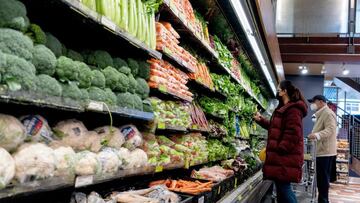CalFresh: Can undocumented immigrants get food stamps?
CalFresh benefits are sent each month in California to help residents afford nutritious food, but can immigrants apply for them? Here’s who qualifies.

The federal government has several nutrition programs, including the Supplemental Nutrition Assistance Program (SNAP), also known as food stamps.
SNAP provides money to low-income families to purchase certain foods. The financial aid is deposited onto an Electronic Benefit Transfer (EBT) card, which works like a debit card for purchases at authorized retailers.
Although it is a federal program, it is administered by each state, so the name and requirements may vary from state to state. In the case of California, this program is known as CalFresh. But are immigrants eligible? Here’s who qualifies.
Immigrants who can apply for CalFresh
Generally speaking, immigrants without regulated status, or undocumented, cannot apply for SNAP or CalFresh benefits. However, there are exceptions depending on each home. A household can receive CalFresh if at least one person (including children):
- Has US citizenship
- You have a permanent residence card, also known as a 'green card' (for any period of time)
- You have refugee or asylum status
- Has been on parolee status for at least one year (Ukrainians admitted to probation may qualify before completing the one-year lapse)
- Has, or is applying for a U-Visa or a T-Visa
- You are an applicant for VAWA (Violence Against Women Act) relief
- He is a Cuban or Haitian immigrant
- As an Afghan entering on a special immigrant visa (SIV), (SQ/SI) Parole, or other forms of humanitarian parole
- You are Hmong/Laotian or Native American born in Canada
An individual does not qualify for CalFresh if:
- You have a student, work or tourist visa
- You benefit from the DACA program
- You are in the United States under the TPS (Temporary Protected Status) program
- You are undocumented
- If you are not eligible due to your immigration status, you can apply for benefits on behalf of other members of your household, such as your children born in the United States
Requirements to apply for CalFresh
According to the benefits.gov portal, to be eligible for this program, an individual must be a resident of the state of California and meet one of the following requirements:
- You have a current bank balance (savings and checking combined) less than $2,001
- You have a current bank balance (savings and checking combined) less than $3,001 and share your household with one of the following:
- a person or persons aged 60 or older or
- a person with a disability (a child, your spouse, a parent, or yourself)
If your household includes a person with a disability or someone over age 60, your eligibility is based on your net income. To qualify, you must also have an annual household income (before taxes). Here you can check the limits based on the members of your household.
Millions of Californians are eligible for #CalFresh! Applying is easy, so learn more about eligibility today: https://t.co/lGHyAit17r pic.twitter.com/uusNRktObX
— CA Health & Human Services (@Cal_HHS) January 6, 2024
You may be interested in: New minimum wage in California in April 2024: how much it increases and who will receive it
How much money is sent each month from CalFresh benefits?
Amounts sent depend on household size, as well as other income factors and other requirements. In California, the average payment per household member is $196 per month. These are the maximum amounts a family can be eligible for in the state:
- 1 household member: $291 dollars
- 2 members: $535
- 3 members: $766
- 4 members: $973
- 5 members: $1,155
- 6 members: $1,386
- 7 members: $1,532
- 8 members: $1.1751
- Additional member: +$219
These are the CalFresh payment dates each month
The exact deposit date for CalFresh benefits is determined based on the last digit of each beneficiary’s case number. Disbursements go from the first day to the 10th of each month,
Last digit of case number is:
- 1: first day of the month
- 2: second day of the month
- 3: third day of the month
- 4: fourth day of the month
- 5: fifth day of the month
- 6: sixth day of the month
- 7: seventh day of the month
- 8: eighth day of the month
- 9: ninth day of the month
- 0: tenth day of the month
Benefits are sent even if the dates are weekends. Additionally, any remaining balance on your EBT card from the previous month is added to the next month's balance.
What can you buy with the EBT card?
The EBT card can be used only to purchase certain foods anywhere that accepts coupons or CalFresh. According to the United States Department of Agriculture (USDA) Food and Nutrition Service portal, you can purchase any food for your home, such as:
- Fruits and vegetables
- Meat, poultry and fish
- Dairy products
- Breads and cereals
- Other foods such as snacks and non-alcoholic drinks
- Seeds and plants, which produce food for the home
On the other hand, recipients cannot use the EBT card to purchase beer, wine, liquor, cigarettes or tobacco, vitamins, medications and supplements, hot foods, or any non-food items, such as cleaning supplies and hygiene items.
Where can the EBT card be used in California?
These are the supermarkets that accept the purchase of items with the EBT card in California, according to the USDA Food and Nutrition Service:
- Albertsons
- ALDI
- Amazon
- Andronico's Community Markets
- Big Square
- Brothers Marketplace
- Cardenas Markets
- Co-opportunity Market
- ExtraMile by Jacksons
- Food 4 Less (Kroger)
- Food 4 Less (PAQ)
- FoodMaxx
- Foods Co
- Glen Ellen Village Market
- Gong's IGA Market
- Island Pacific Market
- Jacksons Food Stores
- Jimbo's Naturally
- Lucky Supermarkets
- Mar Val Foods
- Northgate Markets
- Pavilions
- Raley’s
- Ralphs
- Rancho San Miguel Markets
- Safeway
- Sam's Club Scan and Go
- Save Mart Supermarkets
- Sprouts Farmers Market
- Stater Bros.
- Super King Market
- Superior Grocers
- Target
- The Market by Superior
- Victory Produces
- Vons
- Walmart
- Whole Foods
SNAP benefits: How many EBT cards can one person have? And one family?
Because SNAP is a form of financial support provided by the government, EBT cards are limited to one active account per person. In other words, eligible people can only have one active EBT card in their name. This rule was implemented to prevent abuse and reduce scams, in addition to guaranteeing the delivery of benefits to those who really need them.
Related stories
There are specific cases where a family consisting of more than one adult can have access to more than one EBT card, but that will depend on the state’s eligibility rules. If your family meets certain requirements in your state, your household may be issued two cards.
There are also situations in which a person may have more than one EBT card in their name, either because they receive other benefits or because their card had to be replaced due to a theft or state card transfer.


Complete your personal details to comment